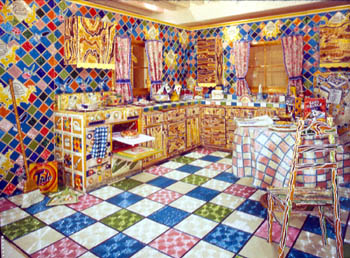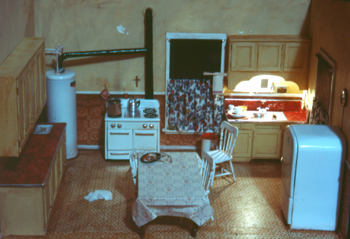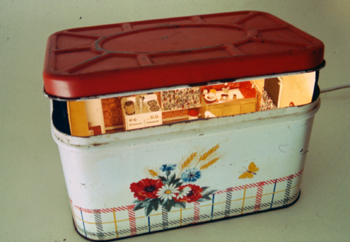![[Metroactive Arts]](/arts/gifs/art468.gif)
[ Arts Index | Silicon Valley | Metroactive Home | Archives ]

Room With an Attitude: Liza Lou's room-size installation 'Kitchen' turns drab functionality into a beaded fantasy world. House Unbound Everyday objects get new lives at San Jose Museum of Art's 'Domestic Odyssey' By Michael S. Gant SOMETIMES, the objects we cohabit with the closest become the most invisible. The drinking glasses in the cupboard, the butter dish in the refrigerator, the refrigerator itself. In "Domestic Odyssey," the new exhibit at the San Jose Museum of Art, 18 artists cut through the patina of the mundane to imbue everyday things with new life. Many of the works use ordinary household objects themselves as the base material for sculptural transformations. Brian Goggin's witty 2004 construction Desire for the Other (with the help of Al Honig and Tom Kennedy) seamlessly connects red-vinyl sofa sections to fashion a monstrous, room-filling, bulging centipede creature rising up on its multiple wooden feet to devour an overupholstered easy chair. Furniture unmoored from its functionality is also the subject of Stephen Litchfield's Revised Standard Version series of chairs that he modified, cut down, reshaped or added to in ways that make them unsittable in the real world but without ever denying their essence as body supports. In their tantalizing mix of familiar and funhouse, they resemble conceptual artist David Ireland's Three-Legged Chair of the late '70s. Willie Cole contributes an easy chair assembled from hundreds of high-heeled women�s shoes from the '50s with their soles turned upward. The result is as spiky and uninviting as a porcupine. The piece, titled Made in the Philippines II, bears some political baggage beyond its surrealistic charge--these shoes conjure up both the footwear fetish of ex-First Lady Dictator Imelda Marcos and the sweatshop labor of Filipino women. Marlene Alt puts her furniture--an old-fashioned iron bed frame--to a more mystical purpose. In Still Waters (2002), a ceiling-mounted DVD player projects the image of a cloudy blue field (either the sky or an aerial view through clouds of a lake) onto a rectangular screen that fills the space where the mattress would rest. It creates the sense of ecstatic weightlessness we experience when we dream we can fly. In a very smart transformation of common materials, An Te Liu has assembled pastel-colored foam sponges to construct a mutlicolored floor-to-ceiling tower and a geometric abstract "painting." In the latter piece, Soft #5 (1998), Te Liu deploys the brick-shaped sponges in a 20-by-12 grid; the rigid structure is softened by the varying Lego-block patterns of similarly colored sponges, and the pitted surfaces look like the grain of linen that sometimes shows through the brushstrokes on paintings.
Alternative Universe: Helen Cohen's 'Red Cover Bread Box, Vintage 1940' (1996) features a miniaturized kitchen set inside a tin container. Utensil Strength The real meat and matter of the show lies in the kitchen, the site most fraught with anxiety, especially for female artists. The tools of the household trade--the ironing board, the scrub brush, the bottle of misnamed Joy detergent--are sometimes seen as instruments of oppression. In the kitchen, domestic stops meaning cozy and homey and starts meaning tamed, as in broken. Servants, after all, are often called "domestics." For many of the artists, appliances serve both symbolic and aesthetic functions. Iranian Shadi Ghadirian's Like Everyday (Mesle Harrooz) consists of nine large-size color photos of chador-clad figures with utensils-�a pot, a soup ladle, a broom, the heat plate of an iron-�held up as substitute faces for the real faces we can�t see. These women are defined not by their features but by their assigned tasks. Willie Cole blows up the classic iron shape into a large ritual object fashioned of bamboo, wood, jute and straw that looks like a South Seas island vessel turned upside down. Margarita Cabrera's loosely stitched vinyl Iron Quilt evokes the tedious piece work of low-paid Latina laborers. San Jose photographer David Pace treats the streamlined contours of the iron in a purely formal way with his color photos of nine different irons from different eras arranged in a three-by-three grid. The perfectly framed irons float free against neutral backgrounds, allowing us to scrutinize them as design projects. Pace does the same for nine Eggbeaters of varying vintages from the days before electric mixers and whisks. These marvelous contraptions, each with inventive interlocking curved beaters and oddly canted, brightly colored wood and celluloid handles, are given the full museum artifact treatment. Indeed, Pace's photos deliberately toy with the shift from function to form--they look like extreme examples of the illustrations that fill high-end "collectibles" price guides. The ironic punch comes in Salt & Pepper #1 (2000). The nine vintage condiment pairs include the queasy stereotype of a mammy and Uncle Tom figure. In the exhibit's centerpiece, Liza Lou�s Kitchen, reproduces that familiar space, including a crowded breakfast table, in minute bursting color using millions of tiny, shimmering tubular beads glued to the walls, floors and countertops. It's all there--from the pie in the oven to the bowl of cereal on the table--rendered with a kind of obsessive ness that is both awe-inspiring and a little frightening. The piece is dated 1991�1995, although it's hard to believe that it didn't take at least a decade to finish. Lou has turned the traditional woman's prison into a ritual room as ornate and powerful as the elaborate beaded headdress of a cult priestess. Taking the opposite tack, Yore Wolberger deconstructs a refrigerator, slicing almost all the way through it at impossibly thin intervals (less than half an inch), like a lab tech taking sliver samples of skin tissue. The refrigerator retains its shape, but the metal bands fan out to reveal the freezer box inside. Wolberger takes his saw to a hutch and a coffee table as well, turning them into loaves of sliced wood. Tiffany Forger's oil-and-wax paintings are minimalist exercises riffing off the abstracted repetitive patterns found on the doors of refrigerators. These bland, flat images pretty much disappear among the flashy pieces in the show, and there seems to be no need to show eight of them when one or two examples would have sufficed.
Worlds Within Words The most exciting part of the show is the selection of four pieces by Mountain View artist Helen Cohen, who died in 2002. Cohen created miniaturized worlds within toaster ovens, tin bread boxes, a toy vanity and a deep fryer. These tableaux look like exquisitely detailed movie sets waiting for some Lilliputian movie director to shout "Action!" Behind the glass-front door of Toaster Oven With Faux Wood Grain, Vintage 1978, exists a perfect suburban kitchen and dining nook, lacking nothing but inch-high people. The experience of discovering something wondrous is heightened by the effort necessary to see through the darkened glass of the toaster oven. In Vanity Box With Mirrors, Vintage 1954, a bedroom can be glimpsed hidden await in a partially opened drawer; even the windows at the back are illuminated. The world inside Red Cover Bread Box, Vintage 1940, can barely be seen at all, so narrow is the gap on the partially opened lid. These pieces, made in the late 1990s, deliver the menacing charge of a good Twilight Zone episode. Domestic Odyssey runs through July 3 at the San Jose Museum of Art.
Send a letter to the editor about this story to letters@metronews.com. [ Silicon Valley | Metroactive Home | Archives ]
|
From the March 17-24, 2004 issue of Metro, Silicon Valley's Weekly Newspaper.
Copyright © Metro Publishing Inc. Metroactive is affiliated with the Boulevards Network.
For more information about the San Jose/Silicon Valley area, visit sanjose.com.

